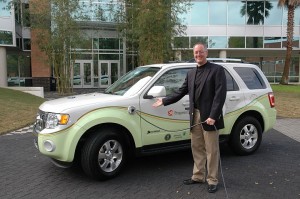Interview and report by Drea Knufken.
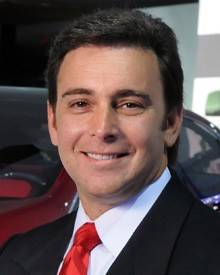
In an economy filled with zombies and sinking ships, the Ford Motor Company stands out as a beacon of success. When the recession corralled Detroit’s Big Three car companies, Ford alone refused a government bailout. But sagging profit margins, a flabby product line and deep debt still infested the multinational automaker.
Things have changed. After consolidating and paring down organizational fat, Ford management launched globally unified strategy called One Ford. To date, the 107-year-old company has reported five straight quarters of profit.
One of the key players in the company’s turnaround was Mark Fields, President of the Americas and executive vice president at Ford. I interviewed Fields while he was at the Paris Auto Show, where the company unveiled its 2012 Ford Focus ST. Here’s what he shared about Ford’s strategy, culture, cars, and future plans.
(Shout out to Kurt and Mike at RideLust: Thank you for your valuable technical input.)
BP: Congratulations on the 2012 Ford Focus ST. It looks like a sweet car. Is this one of the first world cars built under your One Ford plan?
Yeah. Just to put it in perspective, our Fiesta that we launched in the marketplace here about a month or two ago, that’s built up off a global platform, and it shares about 60 to 65% commonality with the other Fiestas sold around the world. It actually launched in Europe, first then it launched in Asia Pacific, mainly China, and then launched here.
We as a North America team participated in the development of that about halfway through its development cycle. So, that was our first foray into global products.
If you switch to the Focus, which is what we’re showing at the Paris show, it’s the first fully fledged global program where from the get go all of the major regions around the world for Ford came together to develop that product together. About 80% of the parts around the world will be shared globally. The other 20%, there’s some regulatory differences between the markets around the world, for example the headlight regulations in Europe are different from the US, those kind of things drive the differences.
BP: When I was reading a bit about Ford’s history, it sounds like Ford has tried to take the world car approach a couple times, but it hasn’t succeeded. What are you guys doing differently this time to make it work?
That’s a great question. Back in the early ’80s we did the Escort. I remember we had a badge on the Escort on the side, and it had the name of the vehicle, and a lot of flags from around the world around the badge to denote that it was a global product. I think at the end of the day it was probably in the single digits, the parts that we shared around the world.
I think there are three fundamental differences this time. First, what we’re seeing today is a lot more convergence of customer requirements around the world than in the past. Things like fuel efficiency. Let’s face it, in the early ’80s it wasn’t high on the list of customers in the US. Now, it’s near on the top of the list. That’s consistent with the rest of the world.
Requirements around safety, quality, around smart technology, there’s a lot more commonality around the world than there used to be. Because in the past when you tried to do global programs, one market would say, “I need these things,” and another would say, “I need these things, by the way half of them are different than what they need.” Then we’d get into horse trading between the markets of what features should we include in the product. Sometimes it was almost like building a camel by committee. And you end up with a camel instead of an integrated product. I think that’s the first fundamental thing. From the customer look in, their requirements are becoming more common around the world.
The second thing is our product development factory is now organized globally. We are really tapping into our engineering resources around the world. For example, on the Focus, we have some great power train engineers in Europe that really know how to engineer small, fuel-efficient power trains. We really tapped into that for the global development for the power trains that are going into the Focus. For lack of a better term, we put in the plumbing around the world to make a global car happen, as opposed to making it real difficult.
It’s almost like going back to the heritage of the company, back the Model T. Henry Ford’s vision was to have the same product, same parts, same manufacturing process around the world. We are going back to the roots of that with these programs. That’s the second thing, we’ve put in the plumbing to allow that.
The third thing is in the industry these days it’s all about scale. With a global program, you get lots of efficiencies in engineering costs. You get lots of savings and investments in your plant. An example is that with all of our plants, we order body shops and dyes where we stamp the fenders and things of that nature. Now what we do is we come up with one design for a dye, and we go to a supplier and say “here’s a design, and I’d like two. Or maybe three. One for U.S., one for Europe, and one for Asia Pacific.”
Before, we would’ve had unique designs where we would go to a supplier and say, “I’ll have one of these.” Europe was doing the same, and Asia was doing something else. So the business requirements to make the business profitable is really driving us. Really, I think it’s those three things that are fundamentally different than the early ’80s.
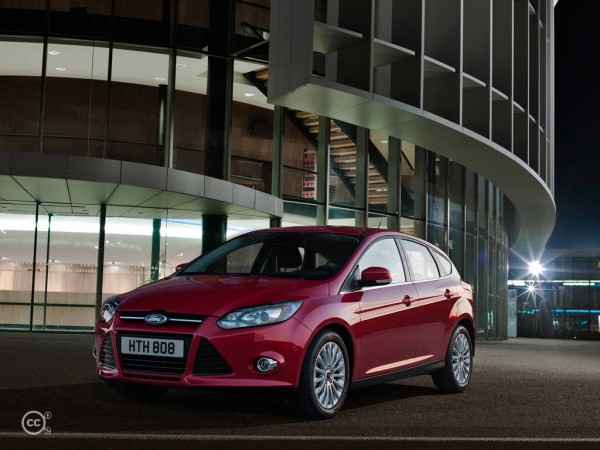
Image: New Focus, Ford Motor Company/Flickr
BP: What about brand equity? My understanding is that Ford has more brand equity in Europe than it does here. How are you going to build up that brand equity here in the States?
Well, I think we’ve really worked hard to build up our image here in the U.S. We measure it. Are you familiar with the purchase funnel?
BP: I’m not.
Basically, it starts at the top. At the top is awareness and familiarity. Then it works its way to favorable opinion, then down to consideration, then purchase intent.
On awareness, obviously everyone is aware of Ford. Whenever we do the studies, there’s only 2-3% of the population that’s not aware of Ford.
The second favorable opinion, we have made tremendous strides over the past two years in approving our favorable opinion in a big way. The results of that in the marketplace is that our market shares are up the 22 out of the last 23 months.
On the transaction prices that people are willing to pay, we are seeing more value in our product and brand, and those two are very important. The third factor is the resale value of your products. Our resale value has improved the most of any manufacturer over the past 2 or 3 years in the marketplace.
We’re going to continue to work with it. We know how precious it is to improve brand equity, we know how quickly you can lose it. That’s why we are keeping focused.
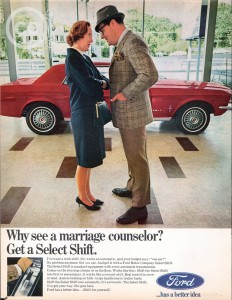
BP: Just talking to people on the street now, it seems like there’s a lot of respect for the new management team. But there’s still a question about the quality of cars. You remember the old Fix Or Repair Daily, right? That whole thing? I’m wondering what is it that you’re doing to build that reputation back up.
(Laughs) There were worse ones than that. I think the first thing we have to do is deliver the goods in terms of quality. We have our own internal quality indicators and they have shown for the past five years that we have improved every year, and we are now statistically tied with the best in the business.
But our own internal metrics aside, external parties, let’s use JD Power for example, we’ve improved 5 years in a row. Every year they do an initial survey, called the initial quality survey that they come out with in June. They basically measure like 50,000 customers of all different brands and they ask, “In your first three months of ownership, how many problems have you had?” And the Ford brand was number 5 in the industry this year. We were the first value brand to crack the top five ever. The only four in front of us were smaller luxury makes.
The important thing is not that we cracked the top five, but it’s also this five years of continuous improvement. It’s that consistency of purpose that every year when customers buy our products, they don’t have to bring it back to the dealerships to get fixed.
That word of mouth builds over time, and you can track our market share growth over the last two years, and it correlates really well with our quality growth. So consumer reports and other third parties are getting their opinions out there on us, and the word of mouth on consumers is so important. I think that’s one of the reasons empowering our market share growth.
The only other thing is, you have to start at the top of the company. And every meeting we have we talk about customer, and we talk about quality. That sets the tone for the rest of the organization.
(Image above: Ford Motor Company/Flickr)
BP: Is this a global thing across the world in regards to meetings?
It always starts with the customer, yes. But if we are in a technical engine architectural meeting, the customer may not creep in much. But most of our meeting are about customers. First, what does this mean to the customer, and secondly, how does this relate back to our strategy for our company, and how does it deliver profitable growth for all? That’s customers and dealers and all.
BP: I would imagine there’s quite a bit of alignment involved in having a company culture like that. Can you tell me about the management structure in Ford, and how you accomplish that unified goal setting?
You’re right, there’s alignment in the management team, especially in a company like ours, and you end up acting very regionally. Then you really just minimize your capability of competing effectively around the world.
Bottom line is we are now organized with clear business unit leaders. In my case, we head up North and South America. So I’m the lead for them. We have a lead for Europe. And we have a lead for Asia-Pacific.
Then, if you think about it, think of those folks as the verticals. Then, going horizontal is all of what we call our skill team leaders. So, manufacturing, purchasing, finance, marketing and sales, HR, you name it. They are horizontal, and what the skill teams do, they help us deliver, as a business unit, successful and growing businesses.
By having that structure, and by meeting every week, and we meet every week as an entire leadership team, which is about 20 or 25 of us around a table every week, we review the status of our business. So in that environment, there’s full transparency.
If I need help in manufacturing, I can make sure that our manufacturing lead can understand that, and he can make sure the folks embedded in my organization are doing what they need to. It’s also a great forum to help each other around the world. It’s really a wonderful structure to not only drive the business effectively, but to your point, get that alignment and reinforce that alignment every week.
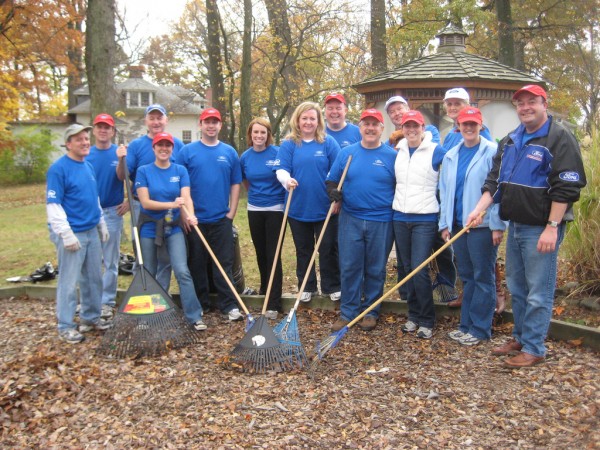
Image of Ford volunteers by Ford Motor Co./Flickr
BP: How do incentives play into that alignment?
Well, basically, all the skill team leaders and the business unit leaders, our incentives really are globally how the company performs. There is some element in the business unit leaders, as you can expect, some element of the business unit performance.
But in my case, for example, part of it is business unit performance, but also a good bit of it is corporate performance. So, that’s a wonderful way of reinforcing to folks that as we run the business, we want to make the right corporate decisions, and not just maximize an individual region’s performance because that may be good for that region, but it may not be good for that total company.
Changing that compensation structure reinforces the behaviors around gaining alignment, gaining enforcement, gaining transparency, and driving the business towards the best results for the total company.
BP: Zooming out a little bit, back to the One Ford plan in general, what has been the hardest part of implementing that plan?
Well, the biggest opportunity that we’ve had on implementing One Ford is just getting everybody to realize the power of working together. I’ve had the good fortune of working in all of the four business units around the world. The way we used to operate was very regionally to be honest. We were a global company, but Europe was wanting to maximize the European business, and if they needed help from the other units they would ask for it. But we were acting very regionally.
Getting everybody to see the power of working together globally has been the biggest eye-opener and opportunity for us and we’ve seen it in our results. And I think on a working level one of the biggest challenges when you’re global is late night or early morning phone calls or webcasts.
BP: Not to mention different business cultures. I can imagine working with your people in China has different requirements than working with people in the U.K. and things like that.
You’re right. You have different country cultures, but the key thing is having one company culture. I think that helps us to work more effectively to understand it. But there will always be different country culture differences.
BP: I’m curious about your strategy regarding EV’s or Hybrids. It seems like you guys are holding back until it’s convenient. The infrastructure is set up for those kinds of alternative cars. Do you think that’s a risky strategy?
I actually don’t think we’re holding back. When you look at our product plan and sustainability, it’s pretty straightforward. We want to make sure we continue to improve the fuel efficiency of internal combustion engines, and that’s why you’re seeing things like EcoBoost from us. Which is basically downsizing the engine and using turbocharging to improve the fuel economy.
We are continuing to invest heavily in hybrids. Obviously we have a couple of hybrids on the marketplace today, and electrified vehicles.
To put it in perspective, by 2012 we’ll have five new hybrid or electric vehicles in the marketplace. Our first one is Transit Connect Electric Vehicle, which comes into the marketplace by the end of this year. The end of next year we’ll have our fully battery electric Focus, then in 2012 we’re going to have two next generation hybrid vehicles.
So I think what we’re trying to do is make sure we provide lots of different solutions for customers in any flavor of ice cream. In terms of fuel economy, our stated goal is to make sure every new vehicle that we introduce into the marketplace in its segment, our aim is to be the leader in fuel efficiency in that segment. A perfect example is our Fiesta that we just introduced and that gets 40 miles per a gallon.
(Image above is from Ford Motor Co.’s Flickr stream)
BP: So it sounds like you won’t have much trouble meeting the US CAFE standards in 2016.
We plan on fully meeting the CAFE requirements. A lot of work goes into that. But we are absolutely committed to make sure we meet that.
BP: What about the Ford Ranger? Why won’t we see a new Ranger in the US?
That’s a really good question. If you think about the Ranger segment, this compact pickup segment, fifteen years ago it represented about 8% of the total industry, and it was a big segment. Let me give you an example, in the month of August, it only represented 2% of the industry. So it has shrunk considerably.
What we have focused on for those customers is really improving the fuel efficiency and performance of our F-Series product. What we’re doing is early next year is we’re introducing all new power trains on our F-Series, including a new V6 engine to really satisfy those Ranger customers. The bottom line is, Ranger in other parts of the world is an appropriate vehicle. We’re focusing on a Ranger for the rest of the world that is actually bigger on the Ranger we have here in the US. In the US, we’re actually focusing on our F-Series.
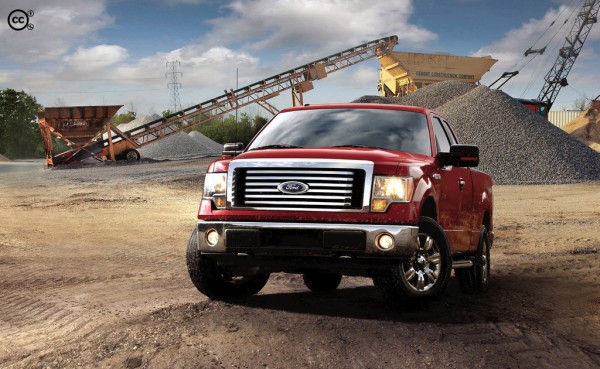
Image: 2011 F-150 XLT, Ford Motor Company/Flickr
BP: I can attest that you guys pretty much own the state of Wyoming with your F-Series.
We love trucks. We’ve also worked really hard to diversify our portfolio of cars, trucks, and utilities. But we are going to continue to invest very strongly in trucks to maintain our leadership and not take that leadership for granted.
BP: What about the Ford Mustang? With more stringent fuel economy requirements coming, how is the Mustang going to change to meet those requirements?
I think if you look at our Mustang in the marketplace today, about six months ago we introduced new power trains into the Mustang. To give you an example, our V6 engine, we have two engines a V6 and a V8. The V6 engine gets 31mpg and 305 horsepower. And the V8 gets 412 horsepower and gets 25mpg. So our engineers can do wonderful things with power trains these days.
And even as we go forward meeting the new CAFE requirements, Mustang is going to continue to have a place at the table because it’s such an economic product for us, and we’ll continue to deliver what customers want in that segment. Which is fuel economy and performance. So we’re going to deliver both.
BP: I’ve heard rumors that Ford will resurrect a halo car like the Ford GT. Can you comment on that?
Not really. At this point, we’ve not announced any plans for a halo car. Our product strategy really revolves around having a full product lineup and small, medium, and large cars, trucks and utilities, and delivering it with the best fuel economy, safety, quality, and smart technology. But, at this point, no news to make around any kind of halo car.

Image: Conner395/Flickr
BP: You also make a fleet for police agencies. Have you been successful in selling the Taurus to those agencies?
On police, we actually command 70% of the police cruiser market with our Crown Victoria. And everybody knows the Crown Victoria because when you’re driving down the road and you see a white Crown Victoria coming the other way people slow down. Right?
BP: Oh yeah.
We introduced, a couple of months ago, our new Police Interceptor vehicle. It is based off the Taurus chassis, but it is a purpose-built Police Interceptor, and that’s going to come in the marketplace late next year. We are still selling the Crown Vic.
So far, we’ve had a lot of good response to the new Police Interceptor and will begin selling it later next year. Also, on top of it, we introduced a new police utility vehicle, so now we’re going to have the most choice in the police market for the police agencies.
BP: Are you concerned about the redesigned Dodge Charger and Chevy Caprice?
Well, it’s always important to take a look at what’s going on in the competition. I think our product is going to speak for itself because we have worked–not only do we have over 50 years of experience in the police market with the products that we have already introduced, but even in the development of the new Police Interceptor, we have something called the police advisory board, which is made up of police captains and fleet administrators from the state, local, and federal levels. We have listened really closely to their input. And combined with our experience in the marketplace over the last 50 years, we really feel we have a superior product that’s really going to meet the needs of the police agencies.
BP: My final question is that diesel and turbo-diesel are pretty common in the E.U. Do you ever see them making it into the US? Or would you design a turbo-diesel motor for the US?
Our strategy has been to focus diesel on our trucks, like in the case of Super Duty. But in the case of diesel in vehicles here, we have decided for the time being to focus on our EcoBoost engines.
The reason for that is a couple of things. One is when you look at the regulatory environment, in Europe for example, the European governments shape their tax machines to really favor diesels. And therefore diesels are a big deal in Europe. They are really good and have come a long way technology-wise in the last 20 years.
Here in the US, it’s a little bit tougher for the American consumer to put that on the kitchen table when diesel prices are more expensive, and in some cases a lot more expensive than a gallon of gas.
So when you look at that, and you look at the costs for diesels and what we call the after treatment equipment that goes on the vehicle, it’s a pretty high premium for customers to purchase diesels.
That being said, if at any point we see diesels really starting to take off in cars, the beauty of our One Ford strategy and using common platforms around the world like the Focus I mentioned, we’ve already developed and designed those diesels and turbo-diesels for Europe. So we could quickly put them in vehicles here for the US. But right now, there are no plans to do so.
Mark Fields is executive vice president, Ford Motor Company, and president, The Americas, a position he assumed in October 2005. In this role, Fields is responsible for all operations involved in the development, manufacturing, marketing and sales of Ford, Mercury and Lincoln vehicles in the United States, Canada, Mexico and South America.
Drea Knufken is a freelance writer, editor, ghostwriter and content strategist. Her work has appeared in national publications including WIRED, Computerworld, National Geographic, Minyanville, Backpacker Magazine and others. For more information, please visit www.DreaKnufken.com. You can also find Drea via her blog, Facebook, LinkedIn and Twitter.
